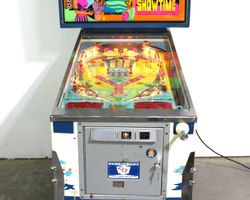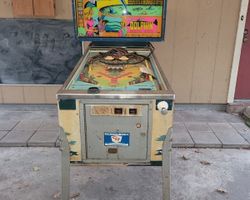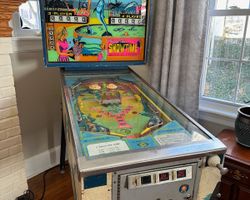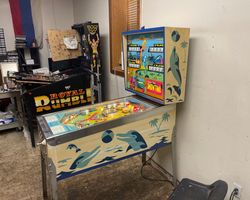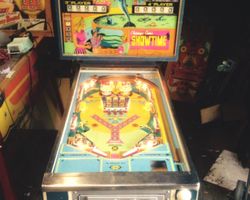Showtime
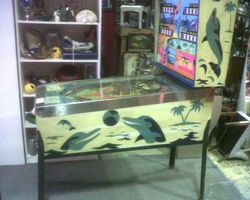
Average Prices: USD $200 to $700
Produced: April, 1974
Machine Type: Electro-mechanical
Players: 4
Design by: Albin Peters, Wendell McAdams
Art by: Christian Marche
Showtime, an electro-mechanical (EM) pinball machine, emerged from the manufacturing facilities of Chicago Coin Machine Manufacturing Company in April of 1974. This four-player amusement, designated as model number 431, was conceived by designers Albin Peters and Wendell McAdams, with the distinctive visual elements crafted by artist Christian Marche. Chicago Coin, a long-standing presence in the coin-operated machine industry, produced 1,088 units of Showtime, contributing to the diverse landscape of pinball during a transitional period for the company and the industry itself. The machine’s thematic core revolved around aquatic enjoyment and a general sense of cheerfulness, an approach reflected in its artistic presentation. Interestingly, a two-player iteration of this design, named "Dolphin," was also released by Chicago Coin in the same year, highlighting the company's strategy of adapting a single core design for different player capacities. Showtime represented a chapter in Chicago Coin's EM production, arriving as solid-state technology began its gradual ascent, though EM machines like this one continued to find their place in arcades and homes.
Signature Features and Design
Showtime stands as a testament to the electro-mechanical era of pinball, relying on physical relays, solenoids, and score reels to drive its gameplay. A defining characteristic of the machine is its central objective: pocketing three captive balls to earn an extra ball. This particular feature serves as the primary strategic element, providing a clear, tangible goal for players to pursue. Visually, Showtime benefits significantly from Christian Marche’s artistic contributions. The playfield and backglass art embrace a vibrant palette, with a notable application of pink that some players found particularly engaging and visually striking. This color choice, coupled with the aquatic theme, imbues the machine with a playful and lighthearted aesthetic. Standard EM sound design is present, featuring three chimes that punctuate scoring events and a distinct knocker for significant achievements, such as an extra ball award. The cabinet itself adheres to a traditional upright design, housing the mechanical score reels that increment points up to 99,990 per player. The manual plunger, a staple of EM machines, offers players direct control over the ball's initial launch.
Playfield and Mechanics
The playfield of Showtime features a straightforward and uncluttered layout, a characteristic often associated with EM designs aimed at accessibility. At the lower end of the playfield, two flippers provide the primary means of ball manipulation, positioned to allow for shots upfield. Above these, two slingshots on either side of the flipper area deflect the ball with force upon contact, contributing to the game's kinetic energy. Two pop bumpers are strategically placed, designed to propel the ball randomly and quickly, adding an element of unpredictability to the upper playfield.
The core interactive elements beyond the flippers and bumpers include seven rollover buttons scattered across the playfield, which award points upon activation. However, the focal point of the playfield mechanics is the trio of captive balls. These balls are semi-fixed targets, typically positioned within a designated area or lane, that can be struck repeatedly. The objective of pocketing all three captive balls is central to the game's strategy, as it directly leads to the coveted extra ball award. The overall design philosophy leans towards an open playfield, which, while simplifying the gameplay, also means fewer obstacles and interactive elements compared to more complex designs. Christian Marche's artwork for the playfield complements this layout, with colorful depictions that reinforce the aquatic theme, blending seamlessly with the mechanical components and simple lighting of the era. This visual simplicity, combined with the clear targets, ensures that the playfield is intuitive to navigate.
Gameplay Dynamics
Showtime’s gameplay dynamics are characterized by their directness and simplicity, distinguishing it within the broader spectrum of pinball machines. The primary objective, as stated, is to pocket the three captive balls. Successfully achieving this triggers an extra ball, providing an immediate and rewarding feedback loop. Beyond this main goal, players accumulate points by hitting various targets: the two pop bumpers, the seven rollover buttons, and the slingshots. An end-of-ball bonus mechanism also adds a layer to the scoring, tallying up points based on collected features or hits throughout a ball's play.
The game's progression is largely linear, centered on accumulating points and reaching the extra ball objective. There are no complex modes or multi-stage objectives, which defines Showtime as a machine built for quick, accessible play sessions. Player strategy primarily revolves around precise flipper control to direct the ball towards the captive balls, maximizing opportunities for the extra ball award. The open nature of the playfield means that the ball often moves quickly, demanding constant attention and quick reflexes, despite the overall simplicity of the ruleset. For players accustomed to intricate rule sets and deep objective structures, Showtime offers a return to fundamental pinball, emphasizing shot accuracy and ball control over complex sequences. This design makes it a suitable introductory machine for new players, allowing them to grasp basic pinball concepts without being overwhelmed.
Reception and Legacy
The reception of Showtime within the pinball community has been varied, reflecting a diverse set of expectations from a machine of its era. Among its strengths, the artwork by Christian Marche frequently garnered positive comments, particularly the appealing use of color and the engaging aquatic theme. Many appreciated the visual distinctiveness it brought to the playfield and backglass. The machine's ease of play was also consistently highlighted as a positive attribute. Its straightforward rules and uncluttered playfield made it highly accessible for novice players or as a casual warm-up game for more experienced enthusiasts. For some owners, Showtime holds a particular appeal due to sentimental value or the specific, uncomplicated enjoyment it provides, offering a break from more demanding pinball experiences.
However, Showtime also faced considerable critique. The most common sentiment revolved around its gameplay, which many found to be overly simple and lacking in long-term engagement. The limited number of unique targets and features meant that the novelty often dissipated quickly, leading to a perceived lack of replayability. The open playfield, while contributing to its ease of play, was also cited as a weakness, with some players wishing for more interactive elements or obstacles to challenge their skills. The four-player version, specifically, was sometimes viewed as an unnecessary expansion, with the additional score reels detracting from the artwork without adding substantial gameplay depth. Compared to contemporary releases from manufacturers like Bally, Gottlieb, and Williams, Showtime was often seen as less complex and less enduring.
Despite the mixed feedback, Showtime occupies a specific place in pinball history. It represents Chicago Coin's approach to EM design in the mid-1970s, prioritizing straightforward enjoyment over intricate mechanics. While it did not introduce groundbreaking features or revolutionize gameplay, it remains an example of the industry's varied output during a significant transitional period. Its legacy is tied to its simplicity; for some, this simplicity is its enduring charm, offering a pure, unadorned pinball experience. It serves as a reminder of an era when clear, singular objectives and mechanical feedback defined the interaction between player and machine.
Sponsored Links
 Ebay Listings
Ebay Listings
 Auction Results
Auction Results
| Cost | Location | Date |
|---|---|---|
| USD $425 |  Maryland, United States Maryland, United States |
26 June, 2025 |
| USD $601 |  Pennsylvania, United States Pennsylvania, United States |
31 May, 2024 |
| USD $3,495 |  Illinois, United States Illinois, United States |
01 May, 2023 |
| USD $800 |  Louisiana, United States Louisiana, United States |
29 December, 2022 |
| USD $1,202 |  Louisiana, United States Louisiana, United States |
08 December, 2022 |
| USD $499 |  Ohio, United States Ohio, United States |
29 May, 2015 |
| USD $300 |  Pennsylvania, United States Pennsylvania, United States |
05 January, 2015 |
| USD $899 |  Georgia, United States Georgia, United States |
19 December, 2012 |
| AUD $722 |  New South Wales, Australia New South Wales, Australia |
09 July, 2010 |
| USD $113 |  Michigan, United States Michigan, United States |
07 June, 2010 |


Private Policy · Search Website · Contact Us
As an eBay Partner, we may earn a commission from qualifying purchases made through links on this site, at no additional cost to you.
All trademarks and copyrighted materials remain property of their respective owners. All other content copyright 2007 - 2025 Pinpedia.

